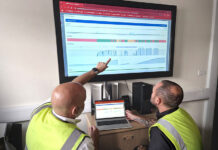Flow-wrapping equipment has been around for a long time, its core features remaining largely unchanged. But user expectations are always rising, calling for things like simpler controls, automatic product feeding, minimum servicing and maximum product reliability. Peter Smith of Redpack explains
MULTI-axis machine drives and control systems have become the norm with flow wrappers, allowing machine configuration to be better tailored to the products being wrapped. End users can enter product settings on a screen for product-to-product changeover.
The latest displays use colour touch screens and let the user do all kinds of diagnostic interrogation, with aspects of machine function represented diagrammatically. Adjustments to print registration and other settings can be made while the machine is in motion.
There has also been a lot of innovation on the product feed side, dispensing with the need for hand loading. Automatic feeding can be simple or very complex depending on the product. Phase feeding uses a series of conveyor belts that synchronise the product feed to the end crimp jaws. It’s a relatively inexpensive automatic feed system, removing the need for operator loading.
Simple and complex feeds
Phase feeding is particularly effective for goods that are flowing along a conveyor from the production process (for example, biscuit bars) or that are being loaded into a punnet (for example, cherry tomatoes).
At the opposite end of the spectrum, a feed system for multi-packing crisps is very complex as the primary packs are not consistent, are relatively fragile, and contain product that is easily crushed.
Furthermore, if a flow wrapper is multi-bagging a six-pack of crisps at 60ppm then the feed system has to be able to deliver 360ppm consistently and in the correct orientation for the flow wrapper in-feed.
Improvements to in-feeds need to go further than just supporting automatic feeding; delicate product has to be handled gently to avoid damage. At Redpack, for example, we have developed a machine to wrap apples without a tray and the in-feed transports the apples without friction or contact with hard surfaces.
Of course improvements in feeding and production throughput bring other challenges. For instance, production has to be halted when the film reel needs to be changed. Stopping the machine flow like this is very disruptive and costly. Developments with auto-splicing the film have negated the need to stop the production flow and in most instances can take place without reducing the machine speed. At Redpack our auto-splice not only saves time but can splice and synchronise print registration at full speed losing only one bag. This improves throughput and prevents film wastage.

Making machines more reliable
Automatic processes and high production rates mean that machines are fully utilised. To accommodate 24/7 operation, machines need to require a minimum of maintenance. Advances in machine drives have assisted this by eliminating much of the old mechanical drive arrangement, which was more of a liability.
Reel handling has been improved by replacing the mechanical shaft braking reel with a geared motor drive that synchronises film speed with product throughput, and the mechanical reel clamp has been discarded in favour of a fast and positive pneumatic clamping system.
End user demand has brought about significant changes in the technology and design of flow wrapping machinery and it has become vitally important for anybody who is about to purchase a new machine to carry out a thorough investigation of the market place before committing to a manufacturer.












